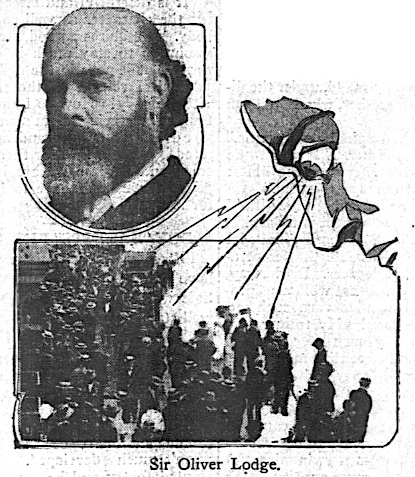
I thought that the whole telepathy things was super popular from the 1950s to the 1960s, but it turns out it was a popular subject even in the 1910s. Here is an old newspaper article that encourages every day people to start practicing telepathy at home.

Can You Read Minds? Great Expert Tells How
Sir Oliver Lodge, the world’s leading psychic investigator, wants you to experiment in mental telepathy, or mind reading.
By “you” he doesn’t mean the so-called high-brow, the learned man or woman who knows all about mind reading and all the successful experiments made. He means that he wants every average man and woman to try to read minds.
Can you read somebody else’s mind?
To enable you to find out whether you or any of your friends are mind readers, Sir Oliver Lodge has given the London correspondent of The Day Book a series of tests, or experiments, calculated to prove or disprove his idea that we are all, to a certain extent, mind readers.
Staff Special.
London, Aug. 13. — In his quest for interesting and illuminating discoveries in the art of mind reading, Sir Oliver Lodge gives the following tests, or experiments for readers of The Day Book.
He asks that everybody try at least one of the experiments.
An easy beginning suggested is this: Send the percipient, or mind reader, out of the room, while the others choose some object, person, or color, upon which they will concentrate their thoughts. Call in the experimenting mind reader. Can he tell what the rest of the party are thinking about? If he can, and there has been no agreement beforehand, he has been able to read your minds.
The mind reader blindfolds himself (the better to concentrate his mind); another person draws on a card something simple, like a cross or circle at first. The card is held in front of the reader, but with the blank side toward him; the other gazes intently at the figure on the card, concentrating his mind upon it.
Can the mind reader describe the figure? A better way is to place a tablet in the mind reader’s hand and allow him to draw the outlines of what he sees. If he can do that, he is making fairly good progress as a mind reader.
The same experiment may be made holding any small object instead of a card, but care must be taken to have the object safely screened from the reader, but fully in sight of the person conducting the test, and it must be his sole subject of thought.
Try conveying the thought of “taste.” Place something in your mouth, anything especially bitter or sweet. Can the reader “taste” it, too?
Numerous other simple experiments will suggest themselves to you as you proceed.
You need not confine your experiments to one person; you may exchange places and do the thought reading yourself; you may even experiment with persons you do not know, trying to read their minds, or trying to convey to their minds the thoughts you are thinking. This is done more frequently than the average person imagines.
Then attempt distance reading. Try the same or similar experiments, having the reader in an adjoining room. If successful, make the distance greater and greater, until you reach a limit. That may be half way around the earth, and it may be but a city block.
A good test would be for a husband and wife to make arrangements to give a few moments during the day, the husband at his work, the wife in the home, thinking deeply about each other, placing their minds in readiness to receive thought messages.
When they meet at the supper table they may recall their thoughts at that particular time of the day and compare notes. Like experiments could be made between any two persons, two women or a mother and her child, and could in time be tried over greater distances, say, for instance, when one is out of town.
Source: The Day Book (Chicago, Illinois newspaper). August 13, 1912.

